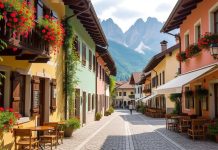Understanding Urban Ecotourism
The Rise of Sustainable Tourism
In recent years, there has been an increasing demand for sustainable and responsible tourism practices. Urban ecotourism has emerged as a significant trend, reflecting a shift in how tourists view their impact on the environment. Rather than traveling to remote natural locations, many tourists are now opting to explore green spaces and sustainable practices within major urban centers.
What is Urban Ecotourism?
Urban ecotourism is a form of tourism that encourages the exploration of natural areas within city limits and emphasizes minimizing environmental impact. This approach highlights the coexistence of urban development and nature, encouraging visitors and locals to engage with and appreciate the green spaces available in cities. This form of tourism promotes eco-friendly practices such as recycling, reduced energy consumption, and learning about local conservation efforts.
Exploring Green Spaces in Cities
Urban Parks and Gardens
Urban parks and gardens serve as the backbone of urban ecotourism. These spaces not only preserve local flora and fauna but also offer city dwellers a place to disconnect from the hustle and bustle of urban life.
Central Park, New York City
Central Park is an iconic example of an urban oasis. Spanning over 840 acres, it offers a sanctuary with its vast meadows, dense woods, and serene lakes. Visitors can engage in various activities such as walking, biking, and bird watching while learning about the park’s history and ongoing conservation efforts.
Highlights of Central Park
– The Ramble: A densely wooded area perfect for bird watching.
– Bethesda Terrace: Offers stunning views and architectural beauty.
– Conservatory Garden: A meticulously curated floral display.
Hyde Park, London
Another quintessential green space is Hyde Park in London. Known for its expansive layout and historical significance, it provides a habitat for many species and a venue for outdoor events and activities.
Key Attractions in Hyde Park
– The Serpentine: A recreational lake offering boating and swimming.
– Speaker’s Corner: A traditional site for public speeches and discussions.
– Kensington Gardens: A meticulously maintained garden adjacent to Hyde Park, featuring the Albert Memorial.
Community Gardens
Community gardens are smaller but significant players in urban ecotourism. They are spaces where local residents grow food and plants collectively, fostering a sense of community and encouraging sustainable agriculture practices.
Significance of Community Gardens
Community gardens serve as educational platforms where city dwellers learn about sustainable agriculture, composting, and the benefits of growing their own food. They also act as green lungs for urban neighborhoods, improving air quality and providing biodiversity hotspots.
Examples of Successful Community Gardens
– South Central Farm, Los Angeles: Once the largest urban garden in the U.S., showcasing the power of community-driven initiatives.
– The Battery Urban Farm, New York City: Focuses on educating local children about sustainable farming practices.
Rooftop Gardens and Green Roofs
Rooftop gardens convert unused urban spaces into eco-friendly habitats. These gardens not only enhance the aesthetic appeal of buildings but also contribute to environmental sustainability by reducing the urban heat island effect and improving air quality.
Benefits of Rooftop Gardens
– Insulation: They provide natural insulation to buildings, reducing energy costs.
– Water Management: Rooftop gardens help in absorbing rainwater, reducing runoff and decreasing the burden on urban drainage systems.
– Biodiversity: They create habitats for urban wildlife, including birds and insects.
Eco-friendly Architecture and Design
Cities around the world are adopting green building techniques that incorporate sustainable materials, energy-efficient designs, and waste-reducing features, enhancing their appeal as urban ecotourism destinations.
Examples of Eco-friendly Buildings
– Bosco Verticale, Milan: Known as the Vertical Forest, it combines residential space with forest-like greenery.
– The Edge, Amsterdam: Considered one of the greenest buildings in the world, using smart technology to maximize energy efficiency.
Engaging Activities in Urban Ecotourism
Eco-friendly Tours and Trails
Many cities now offer eco-friendly tours and walking trails that educate participants about local ecology, history, and sustainable practices.
Guided Walking Tours
Guided tours often focus on themes such as local biodiversity, historical green spaces, and urban wildlife, helping participants develop a profound connection to the city’s natural aspects.
Top Eco-tours
– San Francisco’s Golden Gate Park eco-tour: Explores native plant species and conservation efforts.
– Sydney’s Botanic Garden tour: Showcases local flora and the history of conservation in the area.
Bike and Electric Scooter Rentals
To promote sustainable transportation, many cities have embraced bike and electric scooter rentals. These options offer tourists an eco-friendly means to explore urban spaces while reducing carbon emissions.
Benefits of Green Transportation
– Reduced Carbon Footprint: Encouraging biking and scootering lessens dependence on cars and public transport.
– Health Benefits: Besides environmental benefits, these activities encourage physical fitness.
– Convenience: With dedicated lanes and numerous rental stations, exploring on two wheels has never been easier.
Volunteer and Educational Programs
Urban areas often provide opportunities for visitors to participate in educational workshops or volunteer in conservation efforts, creating a gateway for deeper involvement in urban ecotourism.
Popular Volunteer Programs
– Tree Planting Initiatives: Opportunities in cities like Toronto and Berlin often focus on increasing urban tree canopy.
– Community Clean-Up Drives: Engaging locals and visitors alike in beautifying their environment and fostering community spirit.
Workshops and Educational Outreach
– Sustainable Living Workshops: Covering topics such as zero-waste lifestyles and urban gardening.
– Wildlife Conservation Classes: Providing a closer look at how cities can support diverse animal populations.
Challenges and Opportunities in Urban Ecotourism
Overcoming Urban Challenges
Urban ecotourism presents a unique set of challenges, including overcrowding, pollution, and limited green space. However, cities are addressing these through innovative solutions that turn challenges into opportunities.
Managing Overcrowding
To mitigate overcrowding, cities are implementing reservation systems for popular attractions, thus ensuring a pleasant experience while protecting delicate ecosystems.
Counteracting Pollution
Efforts such as car-free days and emissions monitoring foster cleaner urban environments and enhance the experience for eco-tourists.
Expanding Urban Green Spaces
As cities acknowledge the role of green spaces in improving quality of life, many are investing in expanding their urban forests, parks, and ecological corridors.
Innovations in Green Space Expansion
– Land Reclamation: Transforming vacant lots into community parks or gardens.
– Vertical Gardens: Utilizing building exteriors to increase green areas in space-limited cities.
Fostering Public-Private Partnerships
Such collaborations are pivotal in developing and managing urban ecotourism initiatives. Public entities can leverage private resources, facilitating substantial advancements in sustainability projects.
Successful Partnerships
– Eco-Certification Programs: Governments and private sectors working together to certify and promote eco-friendly businesses.
– Joint Sustainable Infrastructure Projects: Publicly funded construction with green technology provided by private companies.
The Social and Economic Impact of Urban Ecotourism
Benefits to Local Communities
Urban ecotourism can significantly benefit local communities by promoting cultural exchange and providing economic opportunities without compromising on sustainability.
Job Creation
Ecotourism supports various job sectors, including tour guides, conservation specialists, and sustainable product vendors, contributing to local economies.
Cultural Exchange and Awareness
Through interaction with local cultures and communities, tourists gain a better understanding of diverse lifestyles and practices, fostering mutual respect and understanding.
Boosting Urban Economies
In addition to job creation, urban ecotourism stimulates local economies by attracting a constant influx of tourists who contribute to different sectors, from lodging and dining to shopping and entertainment.
Support for Sustainable Local Businesses
– Markets featuring local artisans and sustainable products thrive, offering tourists authentic experiences.
– Eco-friendly accommodations and dining options gain prominence, pushing traditional businesses towards more sustainable practices.
Future Trends and Innovations in Urban Ecotourism
The Role of Technology
With rapid technological advancements, urban ecotourism continues to evolve, integrating digital resources to enhance tourist experiences and conservation efforts.
Smart City Solutions
– Utilization of IoT for real-time monitoring of environmental conditions.
– Mobile applications providing tourists with information on eco-friendly routes and attractions.
Innovative Green Infrastructure
Future urban landscapes will likely emphasize multifunctional, sustainable designs that merge ecological and societal benefits, making cities more livable and attractive to tourists.
Developments in Green Architecture
– Progress in energy-efficient building materials and techniques.
– Expansion of solar panels and wind turbines within city grids.
Sustainable Urban Policies
Governments play a crucial role in guiding cities toward sustainable futures through policy-making and strategic planning.
Strategies for Policy Implementation
– Incentives for businesses adopting sustainable practices, such as tax breaks or certification programs.
– Investment in public transportation systems to lower carbon footprints.
Personalizing the Urban Ecotourism Experience
Tailored Itineraries
Travel agencies and digital platforms now offer personalized itineraries, catering to tourists’ specific interests and time constraints, further enhancing the urban ecotourism experience.
Custom Tours
– Self-guided tours via apps that allow tourists to explore at their own pace.
– Bespoke packages focusing on particular ecological or cultural themes.
Increased Interactions with Locals
For a more authentic experience, tourists are increasingly seeking real interactions with locals, encouraging mutually beneficial cultural exchanges.
Home Stays and Local Meetups
– Staying with local families to gain insights into daily urban life.
– Participation in local events or festivals, fostering deeper connections.
Through these avenues, urban ecotourism continues to thrive, ensuring that cities remain vibrant, sustainable destinations for future generations. This blend of conservation and exploration is reshaping how we view urban areas, not just as concrete jungles but as interconnected ecosystems teeming with life and opportunity.































